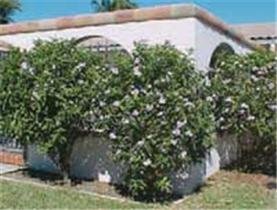Pretty Poisons in the Back Yard
Fig.1 Yesterday, Today and Tomorrow
A warning about "Yesterday, Today and Tomorrow"
With the popularity of lifestyle shows featuring garden makeovers we have begun to see a new type of poisoning case.
Because the symptoms of this plant can mimic anything from Snail bait to Strychnine poisoning, vets may be inadvertently treating the wrong toxin with effective symptomatic treatment and then sending the pet home to be exposed to more of the same.
Whereas fewer and fewer cases of Snail bait and Slug tox are seen due to better owner diligence in how and where the chemicals are applied, more and more vets in the Wollongong and Shellharbour (NSW) area are being presented with pets poisoned by a newish plant in the popularity stakes called 'Yesterday, Today and Tomorrow'. See Fig. 1 (The plant grows well in Sydney, Brisbane and the tropics, and warm, frost free areas in Melbourne and Perth.)
The plant is known by its Latin name Brunfelsia australis or grandiflora and grows as a shrub or small tree. (The flowers are sweetly perfumed and first appear as a violet colour, fading to lavender blue and then white, with the three colours being present on the bush at the same time, hence its name 'Yesterday, Today and Tomorrow'.)
The principal toxin is Brunsfelsamidine, a neurotoxin that causes seizures. The toxin is contained in all parts of the plants but the leaves and flower heads appearing particularly palatable and often eaten in vast quantities. The plant is also often called the 'Chills' plant because of its hallucogenic effect in humans who exhibit shivering and shaking as if extremely cold and chilled.
In the initial stages, or with small amounts ingested, the dogs cough and gag, drool copious amounts of saliva, may or may not have nystagmus and have a wide eyed, spaced-out look with mild to moderate agitation and anxiety. If enough toxin is ingested, seizures similar to Strychnine poisoning can occur and may prove fatal.
The number of cases peak between May and September with some vet clinics seeing up to 3 cases in a given week. Cases can be mistaken for Snail bait, Toad Fish poisoning or Spider bites so it is important to have the owner check any garden the dog may have visited in the last few days for this plant and assess how much of the plant has been ingested. The plant should be dug up immediately and put in the bin as we have had cases where the dog returned home to access the plant in the compost bin.
Contact your vet for appropriate treatment.
Hopefully with increased awareness, this emerging toxin can be diagnosed and treated appropriately.
Author: Dr Aine Seavers, Oak Flats Veterinary Clinic, NSW
This article was published in the Control and Therapy Series, Mailing 242 March 2006, pp. 1675
Reprinted with permission from the Centre for Veterinary Education (CVE), University of Sydney, and the author.
Photo supplied courtesy of one of Aine's clients.
- Last updated 1 April 2006

